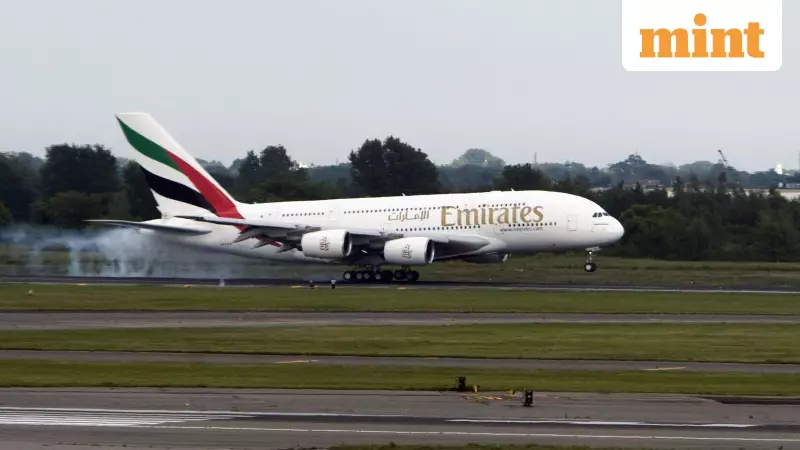
Record Profits and Bilateral Battles: Emirates' India Conundrum
Dubai-based Emirates Airlines has announced its strongest ever half-year performance, recording a phenomenal AED 11.4 billion (US$ 3.1 billion) profit before tax for the first six months of the current financial year. This represents an impressive 17% increase compared to the same period last year, showcasing the carrier's remarkable recovery and strategic positioning in the post-pandemic aviation landscape.
The stellar financial results from Emirates emerged just days after Indian carrier IndiGo reported significant half-yearly losses, primarily attributed to foreign exchange challenges as the Indian rupee continues to weaken against the US dollar. This contrasting performance highlights the divergent fortunes shaping the aviation industry across different markets.
The India-Dubai Bilateral Impasse
At the heart of Emirates' growth challenges in the Indian market lies a longstanding deadlock in bilateral flying rights between India and Dubai. The current air service agreement was last revised in February 2014, establishing a weekly seat capacity of 66,000 seats per week from each side. This quota has remained unchanged for nearly a decade, despite repeated attempts by Emirates to secure additional seats and more Points of Call within India.
The bilateral capacity has been completely utilized on both sides, creating significant operational constraints. This saturation has prevented newer Indian carriers like Akasa Air from launching Dubai flights due to the unavailability of quota. The situation regularly sparks debates about protecting Indian carriers versus allocating more seats to foreign airlines like Emirates, which is often regarded as India's de facto national carrier for Dubai routes.
Top executives from both Emirates and Indian airlines continue to engage in public discussions about the contentious issue of expanding bilateral rights. However, these conversations frequently shift focus to the volume of traffic Emirates carries to Dubai and beyond, rather than addressing the core capacity constraints.
Strategic Shift Towards Premiumization
Faced with the bilateral limitations, Emirates has strategically repositioned itself as a premium carrier in the post-pandemic era. The airline has implemented a deliberate premiumization strategy, ensuring that its enhanced service quality commands premium fares across all classes. Regular travelers have noted this significant shift in positioning and pricing strategy.
While route-specific profitability data remains undisclosed, preliminary fare analysis indicates that Emirates has been systematically pushing its pricing upward across all service classes. Data from India's aviation regulator, the Directorate General of Civil Aviation (DGCA), reveals exceptionally healthy load factors exceeding 90% for Emirates in the Indian market, though load factors alone don't fully capture revenue performance.
During the pandemic, Emirates made a crucial decision to introduce Premium Economy class, commencing commercial operations in 2021 and beginning retrofitting programs in 2022. The airline plans to progressively equip all aircraft with this new service class, reflecting its commitment to premium offerings.
Changing Market Dynamics
Over the past decade, since Emirates last received incremental allocation for India, the aviation landscape has undergone significant transformation. Data from aviation analytics company Cirium reveals that Emirates' market share in India's international aviation sector has substantially declined. In April 2015, Emirates commanded 10.6% of all international seats and 7.9% of capacity by Available Seat Miles (ASM) from India. These figures have now dropped to 6.3% and 4.5% respectively.
This decline occurred while Emirates remained constrained by seat quotas, as other international airlines expanded their India operations and Indian carriers enhanced their international services. Overall seats from India have grown by 65%, with ASM capacity increasing by 73% during this period.
Emirates has pursued cautious growth rather than exponential expansion, partly due to aircraft delivery delays and operational challenges following the pandemic. The airline's India routes accounted for 2.5% of its total ASMs in April 2015, which has decreased to 2.1% currently. Similarly, departures from India now represent 4.7% of its total weekly departures, down from 5.3% in April 2015.
Premium Cabin Expansion
Emirates has significantly reshaped its seat composition for Indian markets, emphasizing premium offerings. The airline now provides 1,148 First class seats per week from India, marking a 19% growth over April 2015 levels. Business class capacity remains substantial, while the introduction of 1,422 premium economy seats represents a completely new product category.
This premium-focused strategy has come at the expense of economy class seats, which have decreased by nearly 5% to Indian markets. This rebalancing has likely increased the average yield on India routes and establishes a foundation for continued premium growth as more aircraft featuring Premium Economy and revamped products join the fleet.
Future Implications
Emirates appears to have successfully created a premium positioning for its services and connectivity options. The ongoing bilateral constraints have forced the airline to adopt a premiumization strategy that enables fare increases without significant incremental costs. This approach also builds passenger loyalty, making it challenging for competitors like Air India to attract customers solely based on price considerations.
Unless Air India can match or exceed Emirates' product quality while leveraging its non-stop flight advantage, Emirates' premium strategy seems well-positioned for sustained success. However, this focus on premium services and higher fares may eventually lead to passenger complaints about pricing, particularly if the bilateral situation remains unchanged and capacity constraints persist.
The strategic impasse continues to shape the competitive dynamics between Middle Eastern carriers and Indian airlines, with passengers ultimately bearing the impact through limited choices and potentially higher fares on one of the world's busiest international aviation corridors.





